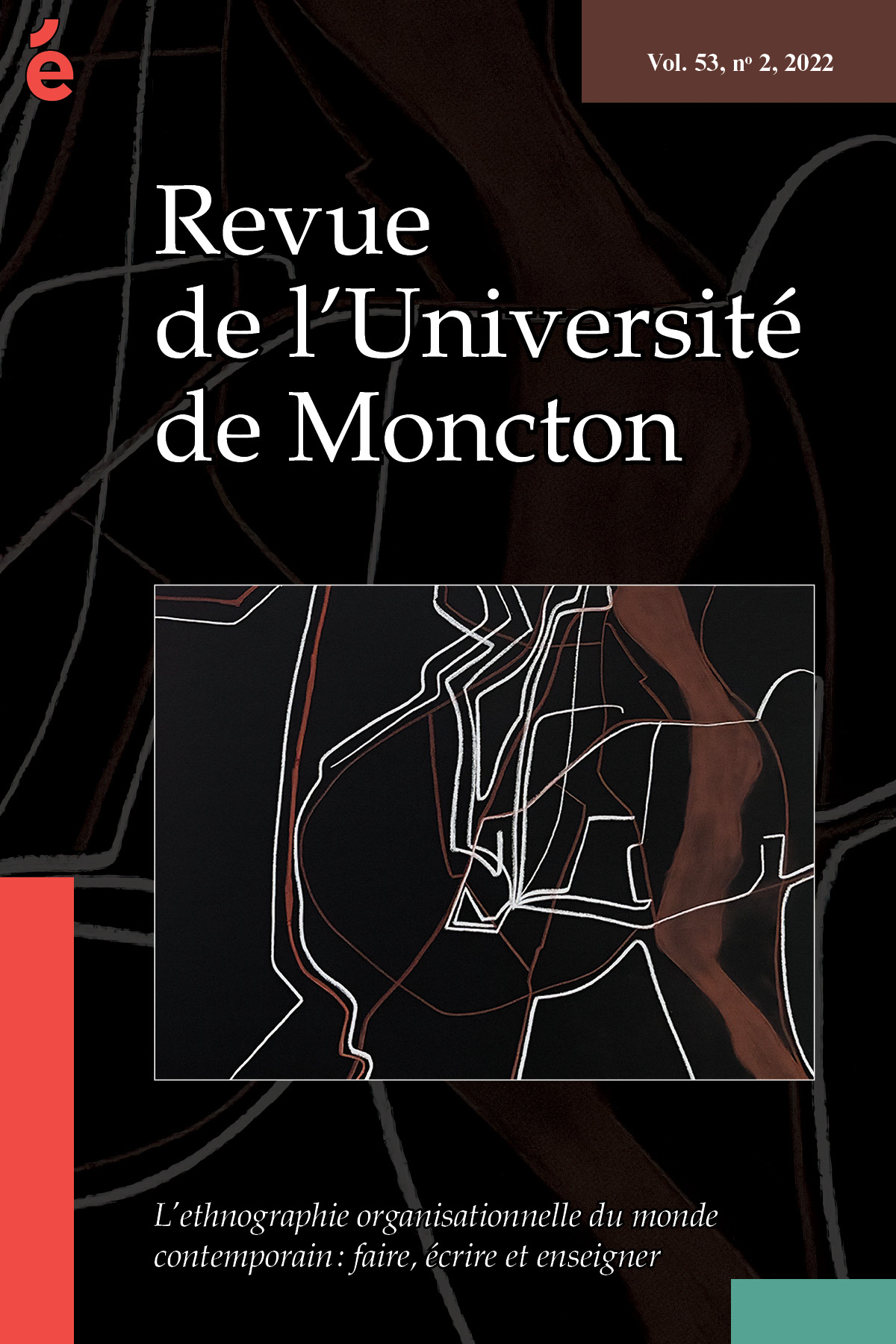Abstracts
Résumé
Cet essai se penche sur l’enseignabilité de l’ethnographie organisationnelle lorsque conçue comme un mode de devenir avec et dans le monde. Notre réponse s’articule autour de trois oxymores qui caractérisent le travail ethnographique, en tant que travail de bureau/tête, travail de terrain et travail d’écriture, soit : (a) Se préparer à l’inattendu, tout en acceptant de ne pas être préparé·e; (b) Ouvrir la voie aux rencontres sur le terrain, sans chercher à les créer; et (c) Rendre à nouveau présent l’irreprésentable par l’écriture. La proposition d’enseignement-apprentissage que nous discutons dans cet essai invite les professeur·es et étudiant·es à apprendre et à désapprendre le travail ethnographique en accueillant à bras ouverts ces oxymores et en naviguant à travers les tensions qui en découlent. Cela demande par le fait même de revoir notre rôle d’enseignant·e comme celui d’un·e accompagnateur·rice qui chemine avec ses étudiant·es et, ce faisant, renouvelle ses apprentissages.
Mots-clés :
- Devenir ethnographe,
- travail ethnographique,
- enseignement-apprentissage,
- oxymore
Abstract
This essay examines the teachability of organizational ethnography, an approach that involves immersing oneself in the world being studied. Our essay highlights three oxymoronic aspects of ethnographic work: (a) Preparing for the unexpected, while accepting to be unprepared; (b) Opening one's voice to field encounters, without seeking to create them; and (c) Making the unrepresentable present again through writing. The teaching-learning ideas we discuss in this essay invite teachers and students to learn and unlearn ethnographic work by embracing these oxymorons and navigating the tensions that arise from them. This requires re-examining our role as teachers as those who accompany their students, and in doing so, continue to develop their own learning.
Keywords:
- Becoming an ethnographer,
- ethnographic work,
- teaching-learning,
- oxymoron
Appendices
Bibliographie
- Aumais, N. et Vásquez, C. (2023). Tisser des relations : dialogue autour de la pratique de la filature 1. Recherches qualitatives, 42(1), 92-113.
- Agar, M. (1986). Speaking of ethnography. Sage.
- Angué, K. (2009). Rôle et place de l’abduction dans la création de connaissances et dans la méthode scientifique peircienne. Recherches qualitatives, 28(2), 65-94. https://doi.org/10.7202/1085273ar
- Bertaux, D. (2016). Le récit de vie (4e éd.). Armand Colin.
- Borges, J. L. (1998). The ethnographer. Dans J. L. Borges (dir.), Collected fictions (trad. de A. Hurley) (p. 334-335). Penguin. (Oeuvre originale publiée en 1969)
- Brummans, B. H. (2007). Death by document: Tracing the agency of a text. Qualitative inquiry, 13(5), 711-727.
- Brummans, B. H. J. M. (2012). The road to Rizong: Buddhist mindful organizing amid natural disaster in the Indian Himalayas. Qualitative Communication Research, 1(4), 433-460.
- Brummans, B. H. J. M. (2014). Pathways to mindful qualitative organizational communication research. Management Communication Quarterly, 28(3), 441-447.
- Brummans, B. H. J. M. (2022). Eight ways to notice mindfully in process organization studies. Dans B. Simpson et L. Revsbaek (dir.), Doing process research in organizations: Noticing differently (p. 173-194). Oxford University Press.
- Brummans, B. H. et Vásquez, C. (2016). A two-step teaching strategy for coping with textualization fever in ethnography. Qualitative Inquiry, 22(2), 119-124.
- Cefaï, D. (2010). L'engagement ethnographique. Éditions de l'École des hautes études en sciences sociales.
- Cordner, A., Klein, P. T. et Baiocchi, G. (2012). Co-designing and co-teaching graduate qualitative methods: An innovative ethnographic workshop model. Teaching Sociology, 40(3), 215-226.
- Corte, U., et Irwin, K. (2017). The form and flow of teaching ethnographic knowledge: Hands-on approaches for learning epistemology. Teaching Sociology, 45(3), 209-219.
- Deligny, F. (2015). The arachnean and other texts (trad. de D. S. Burk et C. Potter). Univocal Publishing.
- Fingerson, L., et Culley, A. B. (2001). Collaborators in teaching and learning: Undergraduate teaching assistants in the classroom. Teaching sociology, 299-315.
- Gilmore, S., et Kenny, K. (2015). Work-worlds colliding: Self-reflexivity, power and emotion in organizational ethnography. Human Relations, 68(1), 55-78. https://doi.org/10.1177/0018726714531998
- Giroux. N. (1997). La construction discursive de l’organisation, Colloque Constructivisme(s) et Sciences de Gestion, IAE de Lille, 23 octobre (373-386).
- Goodall, H. L. (1996). Divine signs: Connecting spirit to community. Southern Illinois University Press.
- Grosjean, S. et Groleau, C. (2013). L'ethnographie organisationnelle aujourd'hui. Revue internationale de psychosociologie et de gestion des comportements organisationnels (Supplement), 13-23.
- Halberstam, J. (2012). Unlearning. Profession, 9-16.
- Harrache, L. L. T. (2017). How did I become an abductive ethnographer? Reflections on a research journey. Journal of Organizational Ethnography, 6(2), 129-143. https://doi.org/10.1108/JOE-03-2017-0017
- Ingold, T. (2000). The perception of the environment: Essays on livelihood, dwelling and skill. Psychology Press.
- Ingold, T. (2008). Bindings against boundaries: entanglements of life in an open world. Environment and planning A, 40(8), 1796-1810. https://doi.org/10.1068/a40156
- Kostera, M. et Harding, N. (dir.). (2021). Organizational ethnography. Edward Elgar Publishing.
- Latour, B. (1990). Quand les anges deviennent de bien mauvais messagers. Terrain, 14, 76-91. https://doi.org/10.4000/terrain.2972
- Lévi-Strauss Cl. (1962). La pensée sauvage. Plon.
- Lincoln, Y. S. et Guba, E. G. (1985). Naturalistic inquiry. Sage.
- Marcus, G. E. (1995). Ethnography in/of the world system: The emergence of multi-sited ethnography. Annual Review of Anthropology, 24, 95-117.
- Marcus, G. E. (1997). The uses of complicity in the changing mise-en-scene of anthropological fieldwork. Representations, 59(Summer), 85-108.
- Manning, E. (2013). Always more than one: Individuation’s dance. Duke University Press.
- Meunier, D., Lambotte, F. et Choukah, S. (2013). Du bricolage au rhizome : comment rendre compte de l'hétérogénéité de la pratique de recherche scientifique en sciences sociales? Questions de communication, 23(1), 345–345. https://doi.org/10.4000/questionsdecommunication.8480
- Nadegger, M. (2023). Reassembling more-than-human sustainability: Relations with snow. Annals of Tourism Research, 101, 1-12.
- Neyland, D. (2007). Organizational Ethnography. Sage.
- Pandeli, J., Sutherland, N. et Gaggiotti, H. (dir.). (2022). Organizational ethnography: An experiential and practical guide. Routledge.
- Pitrou, P. (2014). La vie, un objet pour l’anthropologie? L’Homme, 212, 159-189. https://doi.org/10.4000/lhomme.23786
- Rosch, E. (2008). Beginner’s mind: Paths to the wisdom that is not learned. Dans M. Ferrari et G. Potworowski (dir.), Teaching for wisdom: Cross-cultural perspectives on fostering wisdom (p. 135-162). Springer.
- Rouleau, L. (2013). L'ethnographie organisationnelle d’hier à demain. Revue Internationale de psychosociologie et de gestion des comportements organisationnels, Hs (Supplement), 27-43. https://doi.org/10.3917/rips1.hs01.0025
- Schwartzman, H. B. (1993). Ethnography in organizations. Sage.
- Spradley, J. P. (1980). Participant observation. Holt, Rinehart and Winston.
- Van Maanen, J. (2011). Tales of the field: On writing ethnography (2e éd.). The University of Chicago Press.
- Van Maanen, J. (2011). Ethnography as work: Some rules of engagement. Journal of Management Studies, 48(1), 218-234. https://doi.org/10.1111/j.1467-6486.2010.00980.x
- Vásquez, C. (2020). (In) habitée par le cancer: récits critiques des trajectoires affectives d’un terrain miné d’émotions. Recherches qualitatives, 39(2), 193-214.
- Vásquez, C., Brummans, B. H. et Groleau, C. (2012). Notes from the field on organizational shadowing as framing. Qualitative Research in Organizations and Management: An International Journal, 7(2), 144-165.
- Watson, T. J. (2012). Making organisational ethnography. Journal of Organizational Ethnography, 1(1), 15-22. https://doi.org/10.1108/20466741211220615
- Weick, K. E. (1996). Drop your tools: An allegory for organizational studies. Administrative Science Quarterly, 41(2), 301-313. https://doi.org/10.2307/2393722
- Ybema, S., Yanow, D., Wels, H.,et Kamsteeg, F. (2009). Studying everyday organizational life. Dans S. Ybema, D. Yanow, H. Wels, et F. Kamsteeg (dir.), Organizational ethnography: Studying the complexities of everyday life (p. 1-20). Sage.

